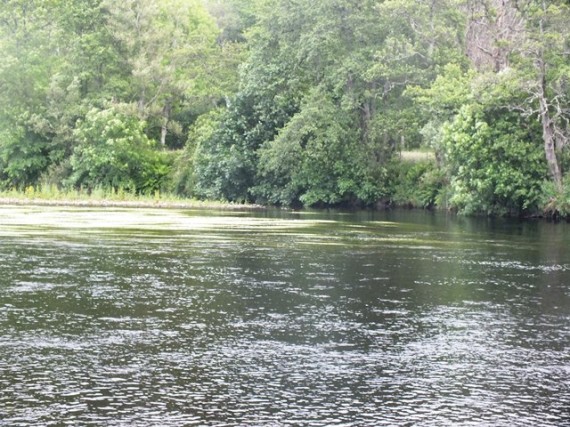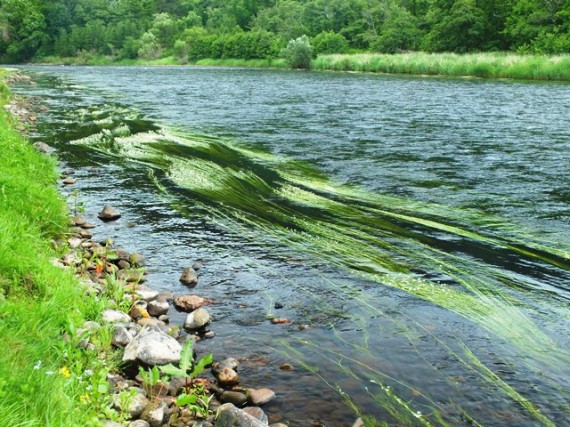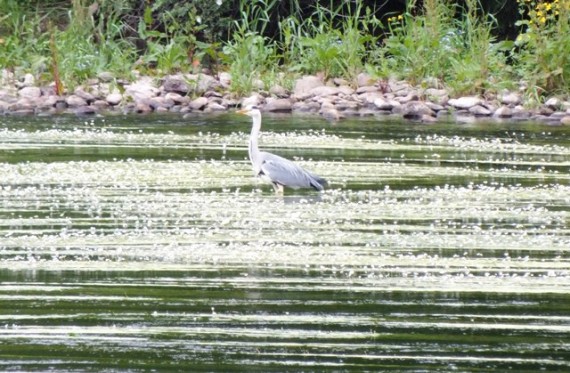I suppose it was inevitable, given the low water and warm summer experienced in 2013 followed by the generally stable river levels over winter that Ranunculus would bloom in the river this year. However many of the ghillies are reporting that it is the worst it has been. The lower river appears to be suffering worse so yesterday I took the opportunity to get some photos at Delfur.

Long streamers of Ranunculus by a boat mooring point. Ranunculus is a very adaptable plant. In the Spey it can be seen growing is slower flowing glides such as this but also in fast flowing riffles and almost still backwaters.

Dense bed of Ranunculus at the tail of the Bridge pool
A ghillies primary role is to ensure that theirs guests have an enjoyable visit and hopefully contact with a fish or two. There are therefore limited opportunities during the course of a long day for other issues such as riverbank management, and increasingly on the Spey weed management. Ghillies throughout the river are having a spend a lot of time hand pulling ranunculus just to keep fishing areas clear. With the weed growing so profusely this year it has become an almost impossible task.

The ranunculus often becomes established in a zone along the riverbank, making landing fish a difficult task. These marginal areas are aslo where many fish are hooked during high water events. If we do get a summer spate this year the fishing will be even more of a challange given the profusion of weed along the margins.

Imagine trying to land a salmon through this weed bed.

The ranunculus does provide cover for juvenile fish as this heron is no doubt aware. It also provides habitat for a multitude of invertebrates but once established it has a major influence on river flows, sediment deposition and biodiversity.
The negative impacts of ranunculus on angling have been mentioned and it is increasingly implicated in the decline of freshwater pearl mussels. In a salmon river the availability of spawning gravels is a key resource. If the ranunculus colonises spawning gravels there is a further impact of another of the species for which the Spey is designated as an SAC. Ranunculus has only been present in the Spey for around 40 years but there is a great deal of frustration at what is percieved to be a lack of action by the authorities responsible for its control.
The correlation between ranunculus abundance and nutrient inputs; be that from point sources such as sewage treatment works and septic tanks or more diffuse sources such as run-off from land, has been made during several distribution surveys. At Grantown it grows in profusion on one side of the river only; coincidently the same side as the sewage treatment works discharge point. However, in the middle river; the Knockando section for example, even this year there is relatively little ranunculus present. This part of the river is relatively distant from major effluent discharges and also benefits from the input of lower nutrient water from the River Avon. Downstream of Aberlour however the ranunculus is probably at its worst. Here there are several towns in succession with associated run-off, industry and more intensive agriculture. The River Fiddich, a naturally more productive water, also joins the Spey and it would appear that in river conditions in this area are highly highly suited for ranunculus, paricularly during low water conditions.
A report on the nutrient status of the Spey in the Aviemore to Grantown area has just been published. This report analysed water quality data collected by SEPA and others and mainly discussed impacts of freshwater pearl mussels. The levels of most nutrient were generally within the accepted thresholds for high status under the Water Framework Directive, although phosphorus gave some cause for concern. However it is possible that levels of nutrients in the lower Spey are locally, and even temporarily, much higher during low water conditions, providing ideal conditions for ranunculus to florish. A study of nutrient levels under these conditions is overdue and could be highly informative.
Ewan McIlwraith used the term “tipping point” on the recent BBC Landward programme feature on the impact of abstraction on the Spey. A very apt term. Some looking at the river now feel that point has been passed as it in places it looks more like a chalkstream than an oligotrohic (low nutrient) highland river. If the Spey is really at that point some serious work is required to a) assess its true status and b) put measures in place to turn the situation around.
Spey Fishery Board
